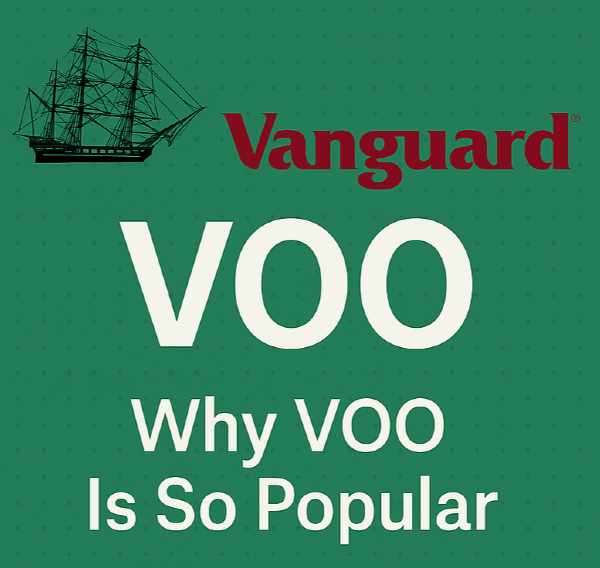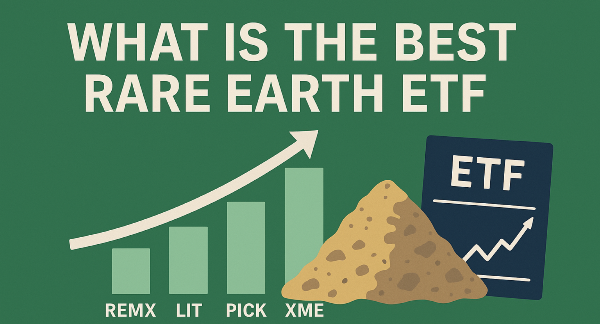Introduction
VOO, the Vanguard S&P 500 ETF, is one of the most widely used investment funds, offering exposure to 500 of the largest publicly traded U.S. companies. As a passively managed ETF, VOO tracks the S&P 500 index, allowing investors to benefit from broad market performance without the complexities of active stock selection. Passive investing has gained popularity due to its cost efficiency and ability to deliver consistent long-term returns. VOO’s low expense ratio, strong historical performance, and sector diversification make it a preferred choice for investors seeking stability and growth.
What Is VOO?
VOO, the Vanguard S&P 500 ETF, is an exchange-traded fund designed to replicate the performance of the S&P 500 index. This index consists of 500 of the largest publicly traded companies in the United States, spanning multiple industries such as technology, healthcare, and financial services. VOO provides investors with broad market exposure, allowing them to participate in the overall growth of the U.S. economy. With a low expense ratio of 0.03 percent, VOO is a cost-effective option for long-term investors seeking diversification and stability.
As a passively managed fund, VOO follows an investment strategy that aims to mirror the S&P 500 rather than actively selecting individual stocks. This passive approach reduces management costs and minimizes portfolio turnover, making VOO an efficient choice for investors who prefer a hands-off strategy. VOO plays a crucial role in tracking the S&P 500 index, which serves as a benchmark for the U.S. stock market. Its high liquidity ensures ease of trading, making it accessible to both individual and institutional investors.
Low Expense Ratio and Cost Efficiency
VOO maintains an exceptionally low expense ratio of 0.03%, making it one of the most cost-efficient ETFs available. This fee structure ensures that investors retain more of their returns over time, as a minimal portion is allocated to fund management costs. Compared to actively managed funds, which often charge expense ratios exceeding 0.50%, VOO provides a highly affordable way to gain exposure to the S&P 500.
Other ETFs tracking the same index have slightly higher expense ratios. Since expense ratios are deducted annually, even small differences can compound over time, affecting overall portfolio growth. VOO’s low-cost structure allows investors to maximize their earnings without sacrificing diversification or performance. Buy-and-hold investors benefit greatly from VOO’s cost efficiency. Additionally, VOO’s high liquidity enables seamless trading, making it easy to enter and exit positions without significant price impact.
Strong Historical Performance
VOO has demonstrated strong historical performance, consistently delivering competitive returns compared to market averages. Over the past decade, VOO has achieved an annualized return of 12.91%, closely mirroring the S&P 500 index it tracks. This long-term growth trend highlights the fund’s ability to capture the overall expansion of the U.S. economy. Unlike actively managed funds, VOO benefits from a passive investment strategy that minimizes costs while ensuring exposure to leading companies.
Stability and growth patterns across different market cycles further reinforce VOO’s appeal. Historical data shows that VOO has recovered well from past recessions, maintaining long-term upward momentum. Several key drivers contribute to VOO’s consistent performance. Additionally, its low expense ratio of 0.03% enhances net returns by minimizing management costs. High liquidity and efficient trading further support its reliability, making it an attractive option for both individual and institutional investors.
Broad Diversification Across Sectors
VOO’s sector weightings reflect the composition of the S&P 500, ensuring broad exposure to key industries. Technology remains the largest sector, accounting for approximately 26% of the fund’s holdings. These allocations allow VOO to capture the performance of leading industries while maintaining balanced exposure across different economic sectors. Exposure to technology, healthcare, financials, and consumer goods plays a crucial role in VOO’s performance.
Diversification is essential for risk reduction, and VOO’s sector allocation helps mitigate volatility. By spreading investments across multiple industries, the fund minimizes the impact of downturns in any single sector. Understanding sector weightings and their influence on portfolio performance helps investors optimize their holdings while managing risk effectively.
High Liquidity and Accessibility
VOO is one of the most liquid ETFs available, with consistently high trading volume. This liquidity ensures that investors can buy and sell shares with minimal price impact, reducing transaction costs. High liquidity also contributes to tighter bid-ask spreads, making VOO an efficient choice for both long-term investors and active traders.
Additionally, VOO’s passive management strategy reduces portfolio turnover, further lowering transaction costs. When comparing liquidity between VOO and other ETFs, VOO consistently ranks among the most actively traded funds. While other broad-market ETFs, such as SPY, also offer strong liquidity, VOO’s lower expense ratio makes it a more cost-efficient option.
Investors looking for a balance between liquidity, affordability, and market exposure may find VOO to be one of the best choices for portfolio stability and ease of trading.
Tax Efficiency and Portfolio Management
ETFs like VOO offer significant tax advantages due to their unique structure and trading mechanisms. Unlike mutual funds, which often distribute capital gains to investors annually, ETFs minimize taxable events through in-kind transactions. This process allows authorized participants to exchange securities without triggering capital gains, reducing tax liabilities for shareholders.
Additionally, ETFs generally have lower portfolio turnover compared to actively managed funds, further decreasing taxable distributions. VOO’s structure plays a crucial role in minimizing taxable events, making it an attractive choice for long-term investors. By reducing taxable distributions, VOO helps investors retain more of their earnings, maximizing portfolio growth over time.
Passive vs. Active Investing: Why VOO Wins
Passive and active investing represent two distinct approaches to portfolio management. Passive investing involves tracking a market index, such as the S&P 500, through funds like VOO, which replicates the performance of the largest U.S. companies. Active investing, on the other hand, relies on fund managers selecting individual stocks in an attempt to outperform the market.
VOO consistently outperforms many actively managed portfolios due to its low-cost structure and broad market exposure. The S&P 500 has historically delivered strong long-term growth, making VOO an attractive option for investors seeking reliable returns. Additionally, passive funds avoid the pitfalls of stock selection errors and market timing.
Who Should Invest in VOO?
Investors considering VOO should evaluate their financial goals and investment horizons to determine if it aligns with their strategy. VOO is ideal for those seeking long-term capital appreciation, as it tracks the S&P 500, which has historically delivered strong returns. Additionally, those looking for a low-cost, diversified fund that minimizes management fees may find VOO an attractive option. VOO is suitable for a wide range of investor profiles, including both beginners and experienced market participants.
Assessing individual investment preferences helps investors determine if VOO aligns with their financial needs. Portfolio allocation strategies incorporating VOO should focus on diversification and risk management. Investors can pair VOO with fixed-income assets or international equities to create a balanced portfolio. Those seeking additional stability may allocate a portion to dividend-focused ETFs like SCHD.
Conclusion
VOO’s widespread popularity stems from its low expense ratio, strong historical performance, and broad market diversification, making it a reliable choice for long-term investors. Its passive management strategy minimizes costs while ensuring consistent exposure to the largest U.S. companies, allowing investors to benefit from stable growth across economic cycles.
VOO’s tax efficiency and high liquidity further enhance its appeal, reducing transaction costs and maximizing after-tax returns. Whether for new investors seeking simplicity or experienced market participants looking for a core portfolio holding, VOO remains a favored ETF for those prioritizing long-term financial growth and stability.




























Introduction
VOO, the Vanguard S&P 500 ETF, is one of the most widely used investment funds, offering exposure to 500 of the largest publicly traded U.S. companies. As a passively managed ETF, VOO tracks the S&P 500 index, allowing investors to benefit from broad market performance without the complexities of active stock selection. Passive investing has gained popularity due to its cost efficiency and ability to deliver consistent long-term returns. VOO’s low expense ratio, strong historical performance, and sector diversification make it a preferred choice for investors seeking stability and growth.
What Is VOO?
VOO, the Vanguard S&P 500 ETF, is an exchange-traded fund designed to replicate the performance of the S&P 500 index. This index consists of 500 of the largest publicly traded companies in the United States, spanning multiple industries such as technology, healthcare, and financial services. VOO provides investors with broad market exposure, allowing them to participate in the overall growth of the U.S. economy. With a low expense ratio of 0.03 percent, VOO is a cost-effective option for long-term investors seeking diversification and stability.
As a passively managed fund, VOO follows an investment strategy that aims to mirror the S&P 500 rather than actively selecting individual stocks. This passive approach reduces management costs and minimizes portfolio turnover, making VOO an efficient choice for investors who prefer a hands-off strategy. VOO plays a crucial role in tracking the S&P 500 index, which serves as a benchmark for the U.S. stock market. Its high liquidity ensures ease of trading, making it accessible to both individual and institutional investors.
Low Expense Ratio and Cost Efficiency
VOO maintains an exceptionally low expense ratio of 0.03%, making it one of the most cost-efficient ETFs available. This fee structure ensures that investors retain more of their returns over time, as a minimal portion is allocated to fund management costs. Compared to actively managed funds, which often charge expense ratios exceeding 0.50%, VOO provides a highly affordable way to gain exposure to the S&P 500.
Other ETFs tracking the same index have slightly higher expense ratios. Since expense ratios are deducted annually, even small differences can compound over time, affecting overall portfolio growth. VOO’s low-cost structure allows investors to maximize their earnings without sacrificing diversification or performance. Buy-and-hold investors benefit greatly from VOO’s cost efficiency. Additionally, VOO’s high liquidity enables seamless trading, making it easy to enter and exit positions without significant price impact.
Strong Historical Performance
VOO has demonstrated strong historical performance, consistently delivering competitive returns compared to market averages. Over the past decade, VOO has achieved an annualized return of 12.91%, closely mirroring the S&P 500 index it tracks. This long-term growth trend highlights the fund’s ability to capture the overall expansion of the U.S. economy. Unlike actively managed funds, VOO benefits from a passive investment strategy that minimizes costs while ensuring exposure to leading companies.
Stability and growth patterns across different market cycles further reinforce VOO’s appeal. Historical data shows that VOO has recovered well from past recessions, maintaining long-term upward momentum. Several key drivers contribute to VOO’s consistent performance. Additionally, its low expense ratio of 0.03% enhances net returns by minimizing management costs. High liquidity and efficient trading further support its reliability, making it an attractive option for both individual and institutional investors.
Broad Diversification Across Sectors
VOO’s sector weightings reflect the composition of the S&P 500, ensuring broad exposure to key industries. Technology remains the largest sector, accounting for approximately 26% of the fund’s holdings. These allocations allow VOO to capture the performance of leading industries while maintaining balanced exposure across different economic sectors. Exposure to technology, healthcare, financials, and consumer goods plays a crucial role in VOO’s performance.
Diversification is essential for risk reduction, and VOO’s sector allocation helps mitigate volatility. By spreading investments across multiple industries, the fund minimizes the impact of downturns in any single sector. Understanding sector weightings and their influence on portfolio performance helps investors optimize their holdings while managing risk effectively.
High Liquidity and Accessibility
VOO is one of the most liquid ETFs available, with consistently high trading volume. This liquidity ensures that investors can buy and sell shares with minimal price impact, reducing transaction costs. High liquidity also contributes to tighter bid-ask spreads, making VOO an efficient choice for both long-term investors and active traders.
Additionally, VOO’s passive management strategy reduces portfolio turnover, further lowering transaction costs. When comparing liquidity between VOO and other ETFs, VOO consistently ranks among the most actively traded funds. While other broad-market ETFs, such as SPY, also offer strong liquidity, VOO’s lower expense ratio makes it a more cost-efficient option.
Investors looking for a balance between liquidity, affordability, and market exposure may find VOO to be one of the best choices for portfolio stability and ease of trading.
Tax Efficiency and Portfolio Management
ETFs like VOO offer significant tax advantages due to their unique structure and trading mechanisms. Unlike mutual funds, which often distribute capital gains to investors annually, ETFs minimize taxable events through in-kind transactions. This process allows authorized participants to exchange securities without triggering capital gains, reducing tax liabilities for shareholders.
Additionally, ETFs generally have lower portfolio turnover compared to actively managed funds, further decreasing taxable distributions. VOO’s structure plays a crucial role in minimizing taxable events, making it an attractive choice for long-term investors. By reducing taxable distributions, VOO helps investors retain more of their earnings, maximizing portfolio growth over time.
Passive vs. Active Investing: Why VOO Wins
Passive and active investing represent two distinct approaches to portfolio management. Passive investing involves tracking a market index, such as the S&P 500, through funds like VOO, which replicates the performance of the largest U.S. companies. Active investing, on the other hand, relies on fund managers selecting individual stocks in an attempt to outperform the market.
VOO consistently outperforms many actively managed portfolios due to its low-cost structure and broad market exposure. The S&P 500 has historically delivered strong long-term growth, making VOO an attractive option for investors seeking reliable returns. Additionally, passive funds avoid the pitfalls of stock selection errors and market timing.
Who Should Invest in VOO?
Investors considering VOO should evaluate their financial goals and investment horizons to determine if it aligns with their strategy. VOO is ideal for those seeking long-term capital appreciation, as it tracks the S&P 500, which has historically delivered strong returns. Additionally, those looking for a low-cost, diversified fund that minimizes management fees may find VOO an attractive option. VOO is suitable for a wide range of investor profiles, including both beginners and experienced market participants.
Assessing individual investment preferences helps investors determine if VOO aligns with their financial needs. Portfolio allocation strategies incorporating VOO should focus on diversification and risk management. Investors can pair VOO with fixed-income assets or international equities to create a balanced portfolio. Those seeking additional stability may allocate a portion to dividend-focused ETFs like SCHD.
Conclusion
VOO’s widespread popularity stems from its low expense ratio, strong historical performance, and broad market diversification, making it a reliable choice for long-term investors. Its passive management strategy minimizes costs while ensuring consistent exposure to the largest U.S. companies, allowing investors to benefit from stable growth across economic cycles.
VOO’s tax efficiency and high liquidity further enhance its appeal, reducing transaction costs and maximizing after-tax returns. Whether for new investors seeking simplicity or experienced market participants looking for a core portfolio holding, VOO remains a favored ETF for those prioritizing long-term financial growth and stability.